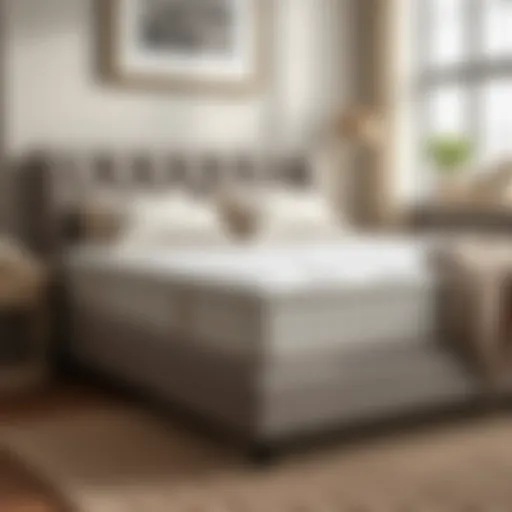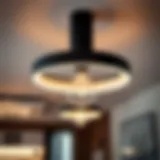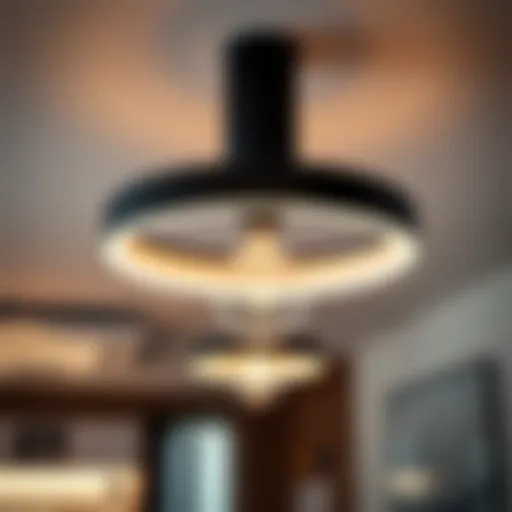Television Tables and Stands: Design Trends and Functionality


Intro
In the realm of home décor, the choices we make about furniture often reflect our tastes, needs, and lifestyles. Among these choices, television tables and stands hold a unique position. They are not just supports for our screens but play a vital role in shaping the overall ambience of a room. As TV sizes grow and design preferences evolve, the functionality and aesthetic appeal of these pieces have never been more significant.
The journey of television tables has been an interesting one. From simple wooden frames to highly tailored modern designs, these stands have transitioned to become focal points in living spaces. This article will guide you through the various dimensions of television stands — touching on current design trends, material innovations, and practical aspects that can assist you in selecting the ideal piece for your home.
With a focus on unique insights, we aim to enrich your understanding of how these elements combine to enhance not just the functionality of your entertainment system but also the entire room’s visual impact. Let's dive into the key trends shaping the future of television furniture, starting with design.
Prelims to Television Tables and Stands
In today's homes, television tables and stands have evolved from mere functional pieces of furniture to significant elements that enhance aesthetic appeal and improve living space functionality. Their importance lies not just in their usability, which is paramount, but in how they harmonize with the overall design of a room. A well-chosen stand can act as the focal point of a living area, complementing or contrasting with other elements of decor.
Moreover, it's essential to consider their practicality. Furniture that accommodates not just the television but also integrates storage solutions for cables, devices, and other media essentials is gaining traction. This reflects a broader trend towards smart living solutions that cater to modern lifestyles. For homeowners and decorators alike, understanding the balance between form and function in television stands is crucial.
Purpose and Functionality
Television tables and stands, at their core, serve a dual purpose. They elevate the screen to a practical viewing height while providing a space to manage various electronic devices, including gaming consoles and media players. Besides the basic functionality, these pieces contribute to the overall organization of the entertainment space. A well-stocked media console can house dvds, books, and decor items, blending style with practicality.
When selecting a television stand, homeowners often must weigh considerations such as size and capacity against style and trend. This balance ensures that the stand meets the user's lifestyle demands, whether it’s for binge-watching series or hosting movie nights with friends. Furthermore, the ability to integrate hidden cable management systems proves beneficial, as it eliminates unsightly cords and creates a cleaner look in the living room.
Historical Context
Historically, furniture has always had a functional basis, evolving from simple wooden shelves to intricate designs that reflect both style and technological advancements. Early television stands were usually bulky and unwieldy, designed purely to support the weight of the television, which at the time was significant.
As technology advanced and televisions became slimmer and more portable, the designs of their stands evolved, too. This shift away from utility-driven aesthetics to more style-conscious designs allowed furniture makers to explore diverse materials and forms. The mid-20th century saw the introduction of materials like molded plastics and metals into furniture design, giving rise to the modern television stand. Homeowners began to view these pieces not just as functional furniture but as integral parts of their living spaces, leading to an increased focus on decor compatibility.
In the present day, the popularity of various design movements, from minimalism to industrial styles, continues to influence how we view television stands. Today’s designers consider the stands as canvases to express contemporary design elements that resonate with an audience seeking both style and substance.
Design Trends in Television Furniture
In the world of home decor, the design of television furniture is not just about function; it's about how these pieces enhance the entire living space. The right television table or stand can transform a simple room into an inviting entertainment area. As times change, so do design philosophies. Understanding the current trends allows homeowners and interior decorators to make informed choices that reflect personal style while meeting practical needs.
Various trends are emerging, each with unique characteristics that can suit diverse tastes. From sleek and modern looks to more rustic and eclectic approaches, these design trends cater to a wide range of preferences, focusing on aesthetics and usability.
Moreover, trends can influence how spaces are utilized, helping create an environment that feels spacious and organized. In an age where minimal clutter is key, selecting the right television furniture is paramount for both form and function.
Contemporary Minimalism
The essence of contemporary minimalism is simplicity and functionality. Characterized by clean lines and a lack of ornamentation, minimalistic designs evoke a sense of calm and organization. Furniture pieces within this style often feature a neutral color palette, making them versatile enough to work in almost any room setting.
When choosing a contemporary minimalist television stand, look for those with hidden storage options. This can include cabinets that keep electronic equipment tucked away, further reducing clutter. Open shelving can make the space feel airier, allowing for minimal decor accents like greenery or few carefully chosen books to shine.
"Minimalism is not a lack of something. It's simply the perfect amount of something." – Nicholas Burroughs
Industrial Style
Industrial style draws inspiration from urban lofts and warehouses, demarcated by robust materials and raw finishes. Think metal frames paired with reclaimed wood, iron accents, and distressed surfaces. This trend taps into a rugged charm, perfect for those who appreciate an edgy, contemporary aesthetic.
Consider a stand that combines these elements to create a striking focal point in your living area. For instance, an open metal frame with wooden shelves can highlight both the texture of the materials and the components hiding within.
It's also about embracing imperfections, valuing them as part of the overall design rather than trying to conceal them. If the stand bears the marks of craftsmanship, it adds character and history, making each piece unique to the home.
Scandinavian Influence
Scandinavian design emphasizes functionality while celebrating craftsmanship and natural materials. Characterized by soft hues, organic shapes, and clean lines, this style promotes a sense of comfort and tranquility. The Scandinavian influence in television furniture serves to create cozy spaces without forgoing style.
When selecting a Scandinavian-inspired television stand, look for wood with light finishes, smooth surfaces, and a mix of textures. Adding a few indoor plants or a textured rug can complement the piece beautifully, creating a serene entertainment zone.


Incorporating natural elements through finishes not only enhances aesthetics but also supports eco-friendly practices, promoting a sustainable approach to furniture selection.
Material Innovations
The landscape of television tables and stands has been reshaped by the innovations in material design. The importance of material innovations cannot be overstated—it directly influences not only aesthetics but also the functionality and durability of furniture. An understanding of these materials allows homeowners and designers to make informed choices that reflect both personal style and utility. As homes evolve into multifunctional spaces, the choice of material plays a pivotal role in how well furniture integrates into this new norm.
Wood: Traditional vs. Modern
Wood has long been the material of choice for furniture makers, owing to its natural beauty and versatility. Yet, there's a distinct divergence in how wood is applied today compared to past designs. Traditional wooden stands often feature intricate carvings and a heavy appearance, celebrating craftsmanship. They possess timeless charm, integrating with various decor styles like a fine wine with cheese. In contrast, modern wooden designs lean more towards minimalism and functionality.
Modern wooden media consoles often use sleek lines and may include engineered wood for weight reduction and cost efficiency. These pieces complement contemporary interiors while still providing the warmth that only wood can offer. Furthermore, reclaimed wood has emerged as a popular choice, marrying sustainability with rustic aesthetics.
The journey from traditional to modern wood design illustrates not just style evolution but also a shift in consumer preferences towards functional and eco-conscious choices.
Metal and Glass Combinations
The blending of metal and glass in television stands creates an alluring mix of elegance and industrial flair. This combination is more than a mere aesthetic choice; it also speaks to the durability and strength of the resulting furniture. Glass shelves, for instance, can enhance the visual flow of a room while allowing light to pass through, making spaces feel less cramped.
Metal frames, often made from steel or aluminum, provide robust support, ensuring that even the heaviest television sets are safely housed. Designs can range from sleek frames to bold, architectural pieces, each adding a unique character to the living space.
Not only are these materials practical, but they also facilitate cable management through smart design integrated into the furniture itself.
"Blending materials in furniture design allows for infinite customization, accommodating both aesthetic desires and functional needs."
Eco-Friendly Options
In an age where sustainability is paramount, eco-friendly materials are reshaping the furniture industry—including television stands. Options like bamboo, reclaimed wood, and sustainable veneers are gaining traction. Bamboo, known for its rapid growth and renewability, is particularly noteworthy; it's not just a sustainable choice, but also offers a unique look with its natural grain.
Furthermore, furniture made from recycled materials emphasizes a commitment to environmental stewardship. These options do not compromise on design or durability, making them appealing to both eco-conscious homeowners and designers.
Legislation and public awareness around environmentally friendly practices encourage manufacturers to seek innovative materials that lessen the ecological impact. Thus, the rise of eco-friendly options offers a chance for consumers to make choices that align with their values, all while enjoying the modern designs available in today's market.
Functionality and Space Utilization
In the realm of interior design, the balance between aesthetics and practicality has never been more critical. It holds especially true for television tables and stands, which serve as essential furniture pieces in our daily lives. The functionality and space utilization of these items contribute significantly to both the ambiance and the overall organization of living spaces. Homeowners and designers alike find that thoughtful placement and versatile designs can transform a cluttered room into an inviting haven.
Storage Solutions
When considering a television stand, storage capabilities dominate the conversation. An effective storage solution is not simply about stuffing items into available spaces; it’s about intelligent design that harmonizes with the room’s layout.
- Types of Storage: It can come in forms such as open shelves for display and closed cabinets for hidden clutter. Open spaces allow for decorative elements, while enclosed compartments hide away undesired yet necessary devices like remotes and gaming consoles.
- Space Maximization: In smaller homes, choosing stands with multiple functionalities, like shelves that double as a gallery, enhances the utility without sacrificing style. The added benefit comes from keeping things orderly, saving time searching for essentials.
- Vertical vs. Horizontal Storage: While horizontal stands can spread out a room visually, vertical designs might maximize storage in a compact fashion by drawing the eye upward, making rooms feel larger. This could be an ideal choice, particularly for apartments or smaller living rooms.
Cable Management Techniques
In a world where technology ensures our lives are easier, it also brings a mess of cables that can detract from the aesthetic appeal of any space. Here’s where effective cable management techniques come into play.
- Built-in Solutions: Many modern television stands are equipped with built-in cable management systems such as cable trays or conduits, ensuring cords are out of sight and neatly organized. As a result, this helps maintain a clean look and prevents tripping hazards.
- Binder Clips and Velcro Ties: For those who may be engaging in DIY approaches, simple strategies like employing binder clips or Velcro ties can keep cables wrapped securely together. This turns an unsightly tangle into a neatly managed arrangement.
- Color Coordination: Another clever tactic is to match the colors of cable covers to the furniture itself, thereby blending in the hardware rather than visually assaulting the space.
"Don’t let messy cables rain on your stylish parade; a well-managed setup speaks volumes about your design savvy."
Adjustable and Multi-Functional Designs
With space being a precious commodity in many homes, adjustable and multi-functional designs take center stage in the discussion of television stands and tables. These designs cater to various needs and preferences, making them ideal for modern living.
- Convertible Furniture: For instance, stands that can be adjusted in height or converted into different forms offer flexibility. Whether hosting a movie night or a dinner party, adaptable furniture accommodates varying activities.
- Space-Saving Designs: Stands that fold away can transform an area, freeing up space when not in use. This is particularly advantageous in tiny homes or where inhabitants prioritize functionality without committing to a permanent footprint.
- Integrated Technology: Some contemporary designs incorporate smart technology, allowing users to control the setup via mobile apps or voice commands, bridging the gap between function and innovation in furniture design.
DIY Projects: Creating Custom Solutions


When it comes to furnishing a home, there’s a certain charm in creating something yourself. DIY projects for television tables and stands not only allow for personalization but also reflect the unique tastes of the individual homeowners. Engaging in these projects offers a blend of creativity, practicality, and economy. In a world where mass-produced furniture dominates, a handmade stand or table can breathe life into an otherwise mundane living space.
Planning and Design Considerations
Embarking on a DIY project requires a thoughtful approach to planning and design. First and foremost, one must assess the existing space. Take stock of the room dimensions and the layout where the television will be displayed. Consider factors such as:
- Height: The optimal viewing height for the television.
- Style: The overall aesthetic of the room. A rustic wood finish might clash with a sleek, modern decor.
- Functionality: Will the stand serve as more than just a platform? Think about whether it needs drawers for storage or shelves for media equipment.
Sketched blueprints can be invaluable—simple outlines on graph paper help in visualizing dimensions. Also, consider how different shapes: rectangular, circular, or even asymmetrical could impact the feel of the room. Once the design takes shape, it's crucial to think about use. Will the piece stand alone, or is it to be part of a broader ensemble with other furniture? The answers to these questions will shape the final product.
Material Selection for DIY Projects
The next step is deciding on the right materials. This choice is vital, as the materials will not only determine the functionality but also the durability and aesthetic appeal of the stand. Some popular choices include:
- Wood: Solid wood like oak or cherry adds warmth and durability. Plywood can work well too, offering a cost-effective and versatile option.
- Metal: Steel or aluminum provide a modern edge. Using metal brackets can improve sturdiness without sacrificing style.
- Glass: A glass top can create a sleek, contemporary look. Just be mindful of weight and thickness to ensure stability.
- Recycled Materials: Old furniture or pallets can be transformed into unique stand designs, which is both economical and environmentally friendly.
Step-by-Step Construction Guide
Once the design and materials are settled, it’s time to get into the nitty-gritty of construction. Here’s a basic guide to constructing a simple media stand:
- Gather Tools and Materials: Ensure you have essential tools on hand—saw, drill, screws, measuring tape, and clamps.
- Cut the Wood: Measure and mark your wood according to planned dimensions. Use a saw for clean cuts.
- Assemble the Frame: Start with the base, securing pieces using screws and wood glue. Clamp together to ensure steady bonding.
- Add Shelves: Once the frame is stable, install any shelves. Consider adjustable shelving for added versatility.
- Finish the Surface: Sanding is essential for a smooth finish. Staining or painting can add flair—choose a finish that complements the overall decor of the room.
- Final Assembly: Put everything together. Ensure all screws are tight, and check for stability.
- Add Protective Pads: To protect your flooring, place felt pads under the legs of the stand.
"The best furniture is one that is born from your own hands—tailored to fit your needs, style, and creativity."
By following these steps, homeowners can create customized television stands that not only serve a function but also become a talking point in the room, showcasing the personality of the space. DIY projects foster a sense of accomplishment and can turn a simple piece of furniture into an expressive, personalized design.
Selecting the Right Television Stand
Choosing the right television stand is akin to fitting the proverbial puzzle piece into its place; it’s crucial for achieving harmony in your living space. A well-chosen stand not only holds your television but also complements the room's aesthetics and functionality. When shopping for a TV stand, several elements come into play. The size and proportion, compatibility with existing decor, and the budget are three critical aspects that can steer your decision. This selection process involves significant benefits ranging from enhanced organization to improved viewing angles. On top of these, the stand can serve as a visual focal point, binding the designs of a room together. With these thoughts in mind, let's dissect the key considerations in detail.
Size and Proportion
Determining the right size and proportion of a television stand is fundamental. A stand that is too large can dominate a space, making it feel cramped, whereas one that is too small risk being dwarfed by the TV itself. It's a balancing act that demands attention. Start by measuring your television. The industry standard is often to match the width of the stand to about 10-15 inches wider than the screen itself for an aesthetically pleasing appearance.
Moreover, consider the height. The ideal viewing height for most sofas is between 42 and 48 inches from the floor, which helps ensure that your eyes are level with the center of the screen. When all dimensions are properly aligned, you create a more enjoyable, ergonomically sound viewing experience.
"A well-measured television stand not only showcases your TV but creates an inviting atmosphere that makes relaxation easy.”
Style Compatibility with Room Decor
Style compatibility is another crucial consideration when picking a television stand. Each room has a personality shaped by color schemes and design themes. If your space leans toward a modern look, sleek glass and metal designs could work wonders. On the other hand, more rustic or traditional settings might beckon wooden pieces with intricate detailing. Knowing your room's vibe will guide you toward the right choice.
Additionally, consider how the finish of the stand interacts with other elements in the room. For example, a dark wood stand may harmonize beautifully with a leather sofa, while a light-colored stand could brighten up a minimalist space dominated by whites and grays. The right choice can enhance the ambiance and ensure the television doesn’t feel like an afterthought, but an integral part of the decor.
Budget Considerations
Finally, budgeting is a practical, yet sometimes overlooked factor in the decision process. High-quality television stands come in a range of prices, from budget-friendly options that serve their purpose to high-end designer stands that offer specialized features and unique craftsmanship.
Determining how much you want to spend involves weighing the stand's function against your financial comfort level. If you’re working with a limited budget, look for sales or consider purchasing from less traditional outlets like online marketplaces. Conversely, if you have the means, investing in a quality stand can pay off in durability and longevity.
Maintenance and Care for Television Furniture
Taking care of television tables and stands goes beyond merely keeping them clean. It is an essential part of ensuring longevity and preserving their aesthetic appeal. Maintenance practices vary with different materials, styles, and designs, but the overarching aim is the same—keeping your furniture in shape for as long as possible. Ignoring this aspect could lead to wear and tear, which not only detracts from the piece’s appearance but can also affect its functionality. By implementing a consistent care routine, homeowners can enhance the furnishings’ life and usability.
Cleaning Techniques by Material
Different materials require distinct cleaning techniques to maintain their unique characteristics. Here’s a breakdown of common materials used in television furniture and their respective cleaning methods:


- Wood: For wooden stands, it's advisable to avoid excessive moisture. Instead, use a soft cloth slightly dampened with water—never soaking wet. Follow up with a dry cloth to prevent water spots or warping, and consider applying a wood polish occasionally to enhance shine and protection.
- Metal: Clean metal surfaces with a microfiber cloth to avoid scratching. For stubborn stains, a mild detergent mixed with water suffices. Wipe it down, and ensure to dry thoroughly, especially around joints and seams to prevent rusting.
- Glass: A glass cleaner or a vinegar-water solution works wonders on glass surfaces. Spray it on and wipe with a lint-free cloth or paper towel. It's straightforward, but be sure to take care while doing so to avoid scratches.
- Fabric: For stands that incorporate upholstered elements, always check the manufacturer's recommendations before cleaning. Most fabrics can handle light vacuuming to remove dust. For stains, a slightly damp cloth with mild soap often does the trick.
Preventive Maintenance Measures
Being proactive in maintenance can prevent many future headaches. Here are several effective preventive measures homeowners can take:
- Regular Dusting: A simple yet effective way to keep surfaces looking pristine. Make it a habit to dust your furniture weekly to avoid buildup.
- Avoid Direct Sunlight: Positioning your television stand away from direct sunlight can help prevent fading and damage over time.
- Use Coasters and Mats: If you frequently place items on your television furniture, such as drinks or decorative pieces, coasters can safeguard against rings and stains.
- Routine Inspections: Spend a few minutes every month checking the stability and integrity of joints and screws. Tighten any loose parts to ensure durability.
- Humidity Control: Wood furniture, in particular, can be sensitive to changes in humidity. Using a dehumidifier in damp spaces can prevent warping and cracking.
Maintaining your television furniture is not merely a chore; it’s a savvy investment in your living environment. By following these cleaning techniques and preventive measures, you can ensure that your stands and tables remain functional and aesthetically pleasing for years to come.
"An ounce of prevention is worth a pound of cure."
Incorporating these practices into your routine would go a long way in preserving the charm and usability of your television furniture. Visit reliable resources like Wikipedia for more insights or engage in discussions on platforms like Reddit to share experiences with fellow furniture enthusiasts.
Future Trends in Television Stands
As technology continues to evolve at breakneck speed, it's essential to recognize how these advancements play a role in shaping the very furniture we use in our homes. With television stands and tables, future trends are steering the ship towards a blend of aesthetics, functionality, and technological integration. Homeowners and designers alike should stay informed about these developments to make educated decisions when selecting or designing a stand. Ignoring these trends could mean missing out on significant benefits that enhance both the usability and visual appeal of a living space.
Smart Technology Integration
Smart technology is quickly becoming a staple in modern households, and television stands are no exception. The rise of smart TVs, streaming devices, and voice-activated assistants is transforming how we interact with our entertainment systems. Imagine a stand that doesn’t just hold your television, but also incorporates wireless charging surfaces, built-in speakers, or even control systems for lighting and sound. This all-in-one approach maximizes convenience, allowing for a more streamlined experience.
- Remote Control Functionality: Imagine being able to control not just your TV, but your entire media experience with a single device or your voice. Smart stands can integrate with platforms like Google Home or Amazon Alexa, offering seamless control.
- Cable Management: With the increase in devices, cable clutter can become a nightmare. Future designs focus on integrated cable management systems that keep wires hidden and organized. This offers a cleaner look and reduces the frustration of tangled cords.
- Multi-Device Synchronization: The ability to connect multiple devices seamlessly is another pivotal feature. Whether it’s a soundbar, video game console, or streaming device, a smart stand will soon manage and sync all your entertainment tech at a single point.
With these integrations, television stands aren't just furniture; they're becoming the command centers of entertainment hubs, pulling together multiple aspects of design and technology.
Sustainable Design Practices
As awareness of environmental issues rises, designers and homeowners are putting sustainability front and center in their choices. Future trends in television stands reflect this shift towards eco-consciousness. Here are some ways this is manifesting:
- Recycled Materials: Furniture that incorporates recycled wood, metals, or composites helps reduce waste. This practice supports a circular economy, which lessens the impact on our planet.
- Sourcing Transparency: Consumers are increasingly demanding to know where materials come from. A sustainable approach considers not only the materials used but also how they are sourced. Designers who prioritize responsible sourcing foster a clearer connection between the product and the environment.
- Energy Efficiency: Beyond materials, the energy consumption of furniture is also being considered. Future stands will likely aim to include energy-efficient components, such as LED lighting that minimizes power usage.
Adopting these sustainable practices not only aids in the fight against environmental issues but also adds a layer of value and authenticity to the furniture piece. Investing in an eco-friendly television stand means also contributing to a more sustainable future.
"The evolution of television stands and tables symbolizes a beginner's hesitation toward embracing both aesthetic pleasure and technological advancement."
As we move forward, merging technology with sustainable practices will define the future landscape of television furniture. Embracing these trends can elevate not just the functionality of our living spaces, but also their ecological footprint.
The End: The Relevance of Television Tables and Stands
In the context of modern living spaces, television tables and stands might initially seem like simple furniture pieces, but their relevance extends far beyond mere aesthetics. They serve critical roles that blend functionality with design, making them indispensable in any home or workspace. As society advances, personal and technological needs evolve, underscoring the importance of selecting the right piece of furniture that complements not just a television but the overall living environment.
Choosing the right television stand involves considerations that far outweigh appearance. Homeowners must take into account material durability, size compatibility, and storage capabilities. These tables can enhance the viewing experience while also keeping living rooms organized, thereby reinforcing their value in everyday life. A well-designed stand does not only house a television; it reflects one’s personal style and can also offer functional benefits such as cable management, as discussed in the earlier sections.
More than just a piece of furniture, these stands can be pivotal in creating a cohesive decor that binds the room together. They represent the fusion of art and functionality, aligning with current trends while offering unique solutions to common space issues. To further elaborate, the advancements in material technology have allowed for ecological consideration, which many modern homeowners now prioritize.
"Choosing furniture is much like choosing a partner; it needs to fit well with your lifestyle and bring out the best in you."
In today’s age, where screens dominate leisure activities, a suitable television stand becomes a central element in the home, conveying importance and attention to detail. As design trends lean towards minimalism and sustainability, the multifunctional television stand is not just a trend but a necessity. Hence, the exploration of these furniture pieces showcases the integral role they play in modern-day living.
Summarizing Key Points
As we conclude this article, here are a few pivotal points to remember regarding television tables and stands:
- Design Variety: From Scandinavian minimalism to rustic industrial styles, there are designs to fit every taste and decor.
- Functional Excellence: These stands often incorporate clever storage solutions, cable management systems, and adjustable designs. This leads to improved space utilization.
- Material Matters: The choice of materials influences durability, aesthetics, and sustainability, with options ranging from traditional wood to modern eco-friendly materials.
- Future Trends: Innovations in smart technology integration promise to enhance the functionality and appeal of television stands further.
Through these discussions, readers can appreciate how television stands are not simply an afterthought in design, but rather a central element of functional beauty that can elevate a room’s overall ambiance.
Final Thoughts on Selection and Design
When selecting a television table or stand, it’s critical to engage deeply with both practicality and aesthetic appeal. One should not rush this decision, as the choice can significantly impact the room's look and feel. Consider the following aspects:
- Size and Scale: Ensure the stand is proportionate to the television and the room size; a large stand in a small space can overwhelm.
- Material and Finish: Choose materials that align with both your lifestyle and decor, bearing in mind easy maintenance.
- Style Consistency: The design should harmonize with other furniture pieces and the overall design theme of the space.
While it’s tempting to opt for what’s trendy at the moment, it’s vital to remember that timeless design often overrules fleeting trends. In essence, the right television stands enhance not just the visual dynamics of the space but also contribute significantly to a comfortable and functional living environment. Whether you’re a homeowner, a decorator, or someone seeking DIY solutions, understanding the nuances of television tables will empower you to make informed choices that resonate with both style and substance.















